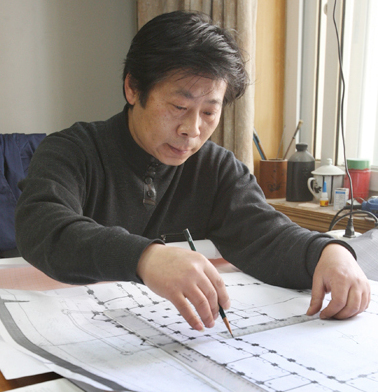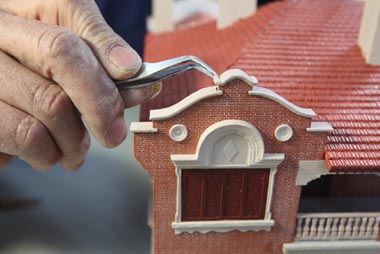 |
|
Guo Zhijun works on the blueprint of the model of the building at 320 Yueyang Road in Shanghai. |
They have the "magic" hands that can bring to life Shanghai's historic buildings. Guo Zhijun and Ouyang Gang are the talents who make miniature models of some of the finer pieces of architecture in the city.
Their impressive repertoire includes the Xuhui High School, Ailu (Love Cottage) and Xujiahui Cathedral, and they will be bringing some of their handmade models to the World Expo 2010 Shanghai.
The wooden model of Xuhui High School was finished just last month.
It's the fourth piece made by Guo and Ouyang. Now they are working on the fifth model of the old building at 48 Pingjiang Road.
It's the former site of the Shanghai government, built in 1919, which is on the list of the Excellent Historical Architecture of Shanghai. Now it's the site of the No. 1 Research Institute of the Ministry of Information Industry. This project will take about 40 days.
Guo is also working on the blueprint of their next project, a model of the building at 320 Yueyang Road, built in 1925. The old house's well-preserved wooden interior is undeniably impressive: The walls on the first and second floors are made of dark wood. In the corridors, stairways and rooms, the wainscots, fireplaces, niches and railings are all in perfect order. All these details will be present in their work.
"These miniature models show the cultural essence of historical architecture in Xuhui District," says Han Jiandong, director of Xuhui District Library and one of the inspirations for the miniatures.
In 2006, Han invited Guo and Ouyang to make a model of the house at 79 Fenyang Road. It is one of Shanghai's protected pieces of historic architecture. It is known as the "Little White Palace" and is now the site of the Shanghai Arts and Crafts Research Institute.
The "Little White Palace" became the first work Guo and Ouyang cooperated on and the beginning of their unexpectedly huge project.
"I was very interested in historical architecture in my own right," Han says. "At first, I invited Ouyang and Guo to make two models of old houses in Xuhui District just for exhibition in the library. I never thought that they would become so absorbed by this.
"Then they made, one by one, the first 'Little White Palace,' then Xujiahui Cathedral, Ailu and Xuhui High School."
Later their work caught the attention of Xuhui District government which decided that this would be the project to represent Xuhui District at the Shanghai Expo.
Making wood models is time and energy-consuming. Standing or repeating one movement for a long time, working with glue vapors constantly - at the day's end, the two are exhausted.
"But we love it and we feel confident and satisfied when a model is finished," Guo and Ouyang say.
Guo studied athletics and drama at school and used to be a poster artist.
Ouyang is a talented ship model maker and has won many awards in ship model competitions in Shanghai.
Model making is a team work, and the sculptors take different roles to bring perfection to the finished work.
 |
|
Making wooden models is time and energyconsuming, like repeating one movement for a long time or working with glue vapors constantly. |
Guo is adept at drawing blueprints and carving flowers, and Ouyang is good at making the small parts of the models. They constantly try to think of new ideas to make the models look 100 percent real, especially in selecting materials and the carving methods used.
The windows were the most complicated part in the making of the model of Xuhui High School.
"There are 397 windows and doors in the school," Guo says. Every window is about 4 centimeters high and consists of seven or eight parts. "Even the windowsills have six smaller parts," he says. As well there are 60 pillars and each 20-centimeter pillar has 10 parts.
All of these miniature pieces have to be made carefully for the texture is just as important. To make every part perfect, they tried all sorts of materials including wood, pottery, paper and plaster. After extremely careful work, heating, carving and glueing, the miniature model finally appears, with every detail as perfect as the full-sized version.
Before they started to make the model of the Xujiahui Cathedral at the beginning of 2007, the team took more than 200 photos. "All the details of the building including the patterns of the relief had to be seen clearly," Guo says. And then he spent three months drawing the blueprint.
There were more than 10,000 parts in the model. The smallest decorative part is only 1 centimeter long. Everything was made and pieced together by hand - it took half a year to finish.
Sometimes the most suitable material is surprising. When you look at the five statues on the pillars in the model of the Xujiahui Cathedral, it's hard to believe that they are made from chalk. White soft chalk was the choice after many trials.
They look very similar to the real plaster figures but they were far more difficult to carve. "Chalk is very easily broken. When we carved we had to be very careful," says Ouyang.
Their team has now grown from three to five, and they are planning to create another 18 models of historic architecture in Xuhui District before the World Expo 2010.
(Shanghai Daily February 18, 2009)